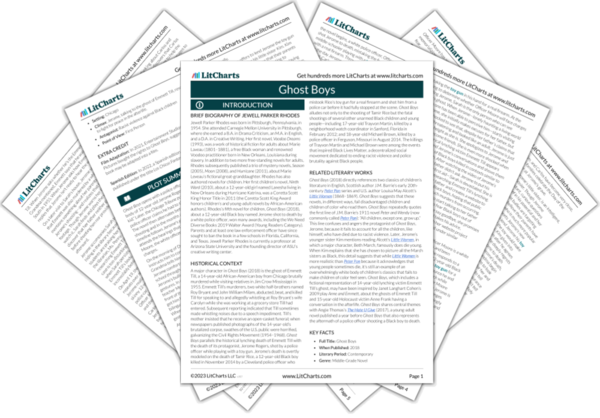Progress, Storytelling, and Justice
Ghost Boys follows the ghost of a 12-year-old Black boy, Jerome Rogers, in the months after a white police officer shoots Jerome while he’s playing outside with a toy gun. By also telling the story of historical figure Emmett Till, a Black boy who was murdered by a lynch mob in 1955, the novel shows how the U.S. has made progress toward racial equality since Emmett Till’s experience in the “Jim Crow”…
read analysis of Progress, Storytelling, and JusticeRacism and the Law
Ghost Boys implicitly argues that while legally mandated racial discrimination has ended in the U.S., the U.S. legal system has remained racist because people enforce the law in racist ways. This argument is clearest in the novel’s representations of Officer Moore, who shoots 12-year-old Black boy Jerome Rogers to death in Chicago, and of the judge who determines whether Officer Moore will be charged with a crime. Officer Moore claims that he is not…
read analysis of Racism and the LawChildhood
Ghost Boys represents childhood as an experience allowed to privileged children but denied to other children, especially boys of color. The novel’s protagonist, a 12-year-old Black boy named Jerome Rogers, is rarely allowed to play outside because his parents fear the drive-by shootings that plague their impoverished, segregated Chicago neighborhood. When a new boy at Jerome’s school, Carlos Rodríquez, offers to lend Jerome a toy gun as a kind of friendship gift, Jerome…
read analysis of Childhood
Fear
Fear is a natural emotion that everyone feels sometimes—but because fear involves implicit belief about the world, Ghost Boys suggests that it is important for people to analyze their fear and overcome it if it is motivated by false, prejudiced beliefs. The novel’s inciting incident is the death of Jerome Rogers, a 12-year-old Black boy who lives in a dangerous Chicago neighborhood. A white policeman, Officer Moore, shoots Jerome to death while Jerome…
read analysis of FearEducation
In Ghost Boys, education might help build an anti-racist future—yet the novel shows how both disadvantaged and privileged children struggle to learn relevant lessons in school, though for different reasons. The novel’s protagonist, a 12-year-old Black boy named Jerome Rogers, struggles to learn lessons relevant to his life because the school in his impoverished Chicago neighborhood lacks resources. His school doesn’t have a librarian. While he would love to learn a foreign language…
read analysis of Education






